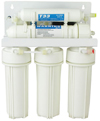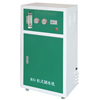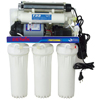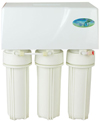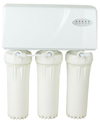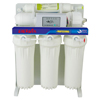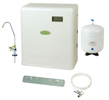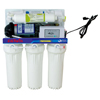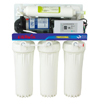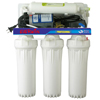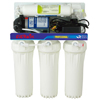Product List
Reverse osmosis (RO) water filtration is a multi-step water filtering process which works slowly but is extremely effective. Reverse osmosis systems are generally used to treat cooking and drinking water supplies. It's often used in industry but works very well in the home. Reverse osmosis uses the principles of osmosis (in which material passes slowly through a membrane and is concentrated and purified in the process) to produce very clean water.
The first step is that a simple sediment filter is installed and all water to be used passes through it; the filter catches large particles of materials such as rust or calcium carbonate (a compound which is not at all harmful but which isn't desirable in your drinking and cooking water - it's commonly used as an antacid). Sometimes a second filter of a similar design, but more fine, is used after the initial filtering. An activated carbon filter traps organic chemicals, and then the RO filter, which is a very fine membrane, is used. It may be helpful to think of all these filters as being similar to sieves with differently-sized holes. Basically, the process of reverse osmosis water filtration would be akin to draining cooked food through a series of increasingly-fine sieves, rather than just emptying the pot into a basic perforated colander. Reverse osmosis water filtration systems, being more complex and increasingly sensitive, can trap far more contaminants than just one simple carbon filter. Some RO systems will, even after the water has passed through the RO membrane, use yet another carbon filter or, alternatively, an ultra-violet lamp, to purify the water even further. The result of all of this filtering is extremely high quality water.







